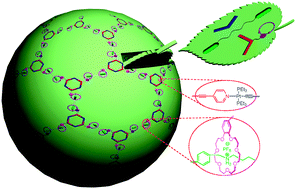Supramolecular polymers constructed by orthogonal self-assembly based on host–guest and metal–ligand interactions
Abstract
Supramolecular polymers constructed by orthogonal self-assembly based on host–guest and metal–ligand interactions are attracting increasing attention currently because of their interesting properties and potential applications. Host–guest interactions impart these polymers with good selectivity and convenient enviro-responsiveness, and metal–ligand interactions endow them with various coordination geometries, strong yet tunable coordination binding abilities, as well as magnetic, redox, photophysical, and electrochromic properties. Therefore, supramolecular polymers constructed by orthogonal host–guest and metal–ligand interactions have wide applications in the fields of soft matter, fluorescence sensing, heterocatalysis, electronics, gas storage, etc. In this critical review, we will address the recent development of supramolecular polymeric systems involving metal–ligand interactions and host–guest molecular recognition. Specifically, we classify the related supramolecular polymers depending on the types of macrocyclic hosts, and highlight their intriguing properties originating from the elegant combination of host–guest complexation and metal centers.


 Please wait while we load your content...
Please wait while we load your content...